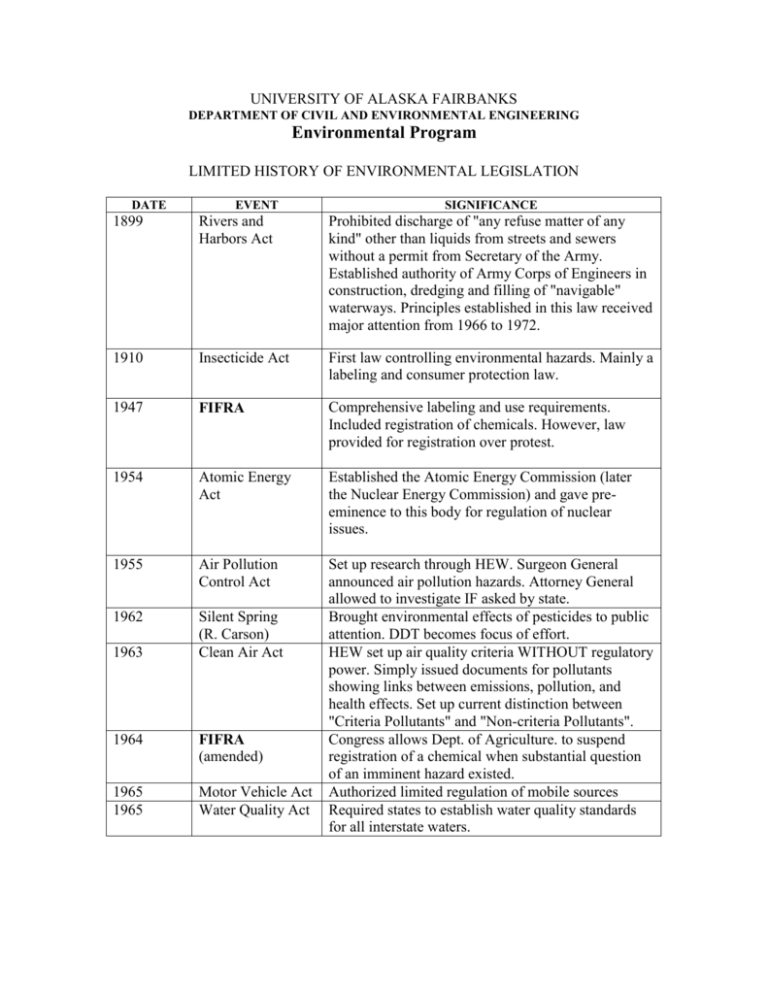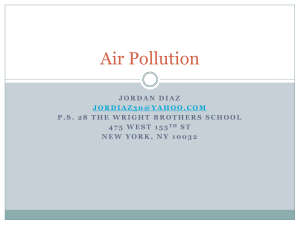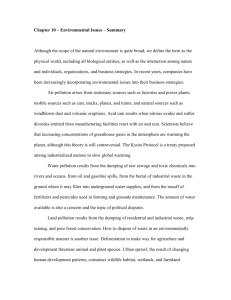historical list of U.S. Environmental Laws
advertisement

UNIVERSITY OF ALASKA FAIRBANKS DEPARTMENT OF CIVIL AND ENVIRONMENTAL ENGINEERING Environmental Program LIMITED HISTORY OF ENVIRONMENTAL LEGISLATION DATE EVENT SIGNIFICANCE 1899 Rivers and Harbors Act Prohibited discharge of "any refuse matter of any kind" other than liquids from streets and sewers without a permit from Secretary of the Army. Established authority of Army Corps of Engineers in construction, dredging and filling of "navigable" waterways. Principles established in this law received major attention from 1966 to 1972. 1910 Insecticide Act First law controlling environmental hazards. Mainly a labeling and consumer protection law. 1947 FIFRA Comprehensive labeling and use requirements. Included registration of chemicals. However, law provided for registration over protest. 1954 Atomic Energy Act Established the Atomic Energy Commission (later the Nuclear Energy Commission) and gave preeminence to this body for regulation of nuclear issues. 1955 Air Pollution Control Act 1962 Silent Spring (R. Carson) Clean Air Act Set up research through HEW. Surgeon General announced air pollution hazards. Attorney General allowed to investigate IF asked by state. Brought environmental effects of pesticides to public attention. DDT becomes focus of effort. HEW set up air quality criteria WITHOUT regulatory power. Simply issued documents for pollutants showing links between emissions, pollution, and health effects. Set up current distinction between "Criteria Pollutants" and "Non-criteria Pollutants". Congress allows Dept. of Agriculture. to suspend registration of a chemical when substantial question of an imminent hazard existed. Authorized limited regulation of mobile sources Required states to establish water quality standards for all interstate waters. 1963 1964 FIFRA (amended) 1965 1965 Motor Vehicle Act Water Quality Act DATE EVENT 1966 Solid Waste Act 1967 Air Quality Act 1968 Wild and Scenic Rivers Act 1969 EDF requests suspension of DDT use 1969 Endangered Species Conservation Act 1970 NEPA 1970 Clean Air Act (amendments) 1970 Noise Pollution and Abatement Act 1971 EDF vs Ruckelshaus 1972 Federal Water Pollution Control Act 1972 FEPCA passed SIGNIFICANCE Established funds for research and development of solid waste management and resource recovery systems. Gave financial and technical aid to states and local governments for planning and development. Gave Federal government research role. (amended) Set up air basin districts, but air quality standards and enforcement left to states. HEW could act only after an extremely complicated process. Started movement towards Emission control from AMBIENT air quality. Authorizes Secretary of the Interior to list selected rivers and their immediate environments as "Wild and Scenic". Once designated, CANNOT be developed, must be left free flowing. Dept. of Agriculture suspends four suspension of minor uses but refuses to suspend major use of DDT (application to cotton). States it will issue further suspensions after study. (Environmental Defense Fund, a non-profit group.) Gives Secretary of the Interior power to list threatened and endangered species. Federal power to stop projects which threaten listed species. Set forth expansive powers for the government in protection of the environment. Established EIS requirement and CEQ. Set up federal ambient air quality standards, however, States to enforce through State Implementation Plans (SIPs). Established EPA and control of FIFRA passed to EPA. Provided limited authority to EPA to enforce air quality standards and state compliance with air quality plans. Established Office of Noise Abatement and Control (ONAC) within the EPA to investigate and study noise pollution and its effects on health. District of Columbia Court rules that EDF has standing and that EPA Administrator MUST suspend registration when a "substantial question of an imminent hazard exists". DDT registrations canceled in September. Required area wide or regional approach for handling pollution. Gave EPA authority to assume responsibility itself in those states that do not comply. Imposed Federal standards on state standards established under1965 Act. Established NPDES Permit system. Extension of FEFRA (Federal Environmental Pesticide Control Act. Adds public health regulations and requires analysis of risks and benefits of pesticide use for registration, restricted registration, cancellation or suspension. DATE EVENT 1972 Noise Control Act 1972 1975 Marine Protection Research and Sanctuaries Act Transportation Act 1976 TSCA 1976 RCRA 1977 Clean Air Act 1977 Clean Water Act SIGNIFICANCE Gives authority to ONAC to specify noise limits for products distributed in commerce. Regulates ocean dumping. Limits dumping of material that could" adversely affect human health, welfare, or amenities". Contains HMTA (Hazardous Materials Safety Transportation Act) that authorizes the Secretary of Transportation to issue and enforce strict performance, design and information standards. Gave EPA power to regulate almost all existing nonregulated chemicals. Also shifted "burden-of-proof to manufacturers for registration. TSCA is unusual as an environmental statute because it controls USE, not disposal. However, the "action-forcing" deadlines and citizen suit provision have not been as effective as in other environmental laws. Also only LAW to specifically impose treatment standards. Regulates PCBs. Passed 10 days after TS CA. Provides for the formal identification of wastes as hazardous, written manifests tracking all waste transportation, and certification, through a permit system, that performance standards for safe treatment, storage, and disposal are being met. Allowed EPA to impose mandatory insurance requirements of toxics generators, handlers, and disposers. Amendments limit EPA's ability to enforce law through transportation plans (see Santa Rosa vs. EPA, 1976) but forces EPA to apply Reasonable Available Control Technology (RACT) on all sources in non-attainment areas, and Lowest Available Emission Rates (LAER) on all new sources. Established Prevention of Significant Deterioration (PDS) requirements). Revised 1972 Federal Water Pollution Control Act. Codified the "bubble" concept in EPA regulations. Exempted irrigation flows from regulation under this law. Extended EPA veto power over Army Corps of Engineers § 404 Permit (Wetlands) but retained the Corp as the lead agency in wetlands permit process. Provided for imposition of administrative fines based on economic gains from violation of law. DATE EVENT 1980 CERCLA 1982 Nuclear Waste Policy Act 1986 Superfund Amendments Reauthorization Act Clean Air Act (amendments) 1990 1990 Oil Pollution Control Act 1990 Pollution Prevention Act 1992 Federal Facility Compliance Act SIGNIFICANCE Congressional attempt to bring order to an array of partly redundant in inadequate hazardous clean-up and federal liability laws. Applies primarily to the clean-up of leaking inactive or abandoned sites, and emergency spill responses. CERCLA is different from other laws in that it is not primarily a standard setting law, it instead puts government directly in the role of abating pollution. Does NOT cover oil spills. Government will take title to civilian nuclear power plants and assume responsibility for safe storage or disposal. Established procedure for locating US Nuclear Waste Repository. Reauthorized and funded the "Superfund". Established Hazardous Substance Research Centers. Established Community "Right-to-Know" and worker education programs. Tightened emission control standards on automobiles. Codified the "offset" concept for EPA regulations. Established sulfur dioxide limits for the year 2000 and provided for "offset" credits for early compliance. Permits FEDERAL TAKEOVER of SIP process if states do not have approved SIPs in three years. Established double hull requirements for oil tankers. Regional Assistance Advisory Councils to be established by oil companies and federally certified. Attempt to limit state's ability to impose penalties defeated. The policy of the United States that "pollution should be prevented or reduced at the source whenever feasible; pollution that cannot be prevented should be recycled in an environmentally safe manner, whenever feasible; pollution that cannot be prevented or recycled should be treated in an environmentally safe manner whenever feasible…” This act amends the Solid Waste Disposal Act and states that all Federal agencies are subject to all substantive and procedural requirements of Federal, state, and local solid and hazardous waste laws in the same manner as any private party.





